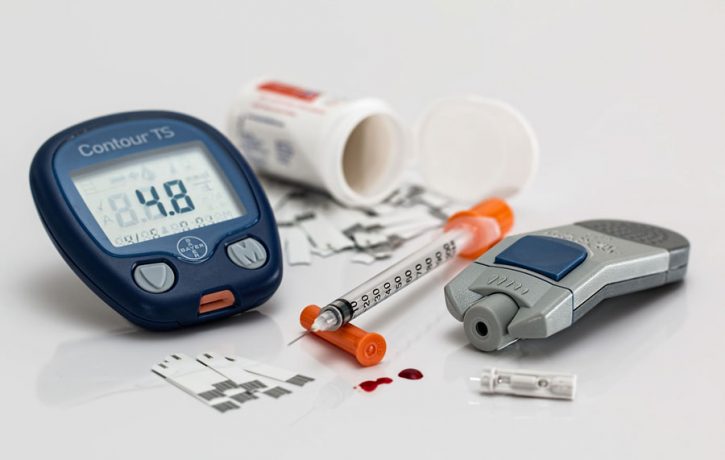in Nutrition
Is Diabetes Reversible?

When someone is diagnosed with diabetes, they will most likely be told that it is a progressive, incurable disease. But is that true?
In the case of type 1 diabetes (T1D), it is, at least for now. In the case of type 2 diabetes (T2D) there is more and more evidence emerging that it is not. It is incurable, but it has been shown to be reversible, most recently in the BBC series “How to stay young”.
Type 1 diabetes is an auto-immune disease in which the beta cells on the pancreas, which produce and secrete insulin, are compromised or even completely destroyed. It is not yet entirely understood why this happens, but as in other auto-immune diseases our immune system is attacking our own body cells, most likely due to molecular mimickry – a case of mistaken identity. The result is that T1 diabetics are unable to produce enough or any insulin, leaving them with dangerously high blood sugar levels. Insulin injections are used to deal with the problem, but there is – as yet – no cure.
Type 2 diabetes, however, is rather different. Here, the pancreas produces – at least to begin with – insulin without a problem. However, that insulin does not work properly and is therefore unable to lower blood sugar as it would in a healthy person. The mechanism of why this happens is still being investigated, but there is no doubt that the underlying reasons are diet and lifestyle related. While there is a genetic susceptibility to developing T2D, just having the gene (as with most other chronic conditions) does not mean that it is inevitable.
Insulin has the job of removing sugar (glucose) from the blood stream. It does this by locking into insulin receptors on the cell walls, which allows the cell to absorb glucose. Without insulin, glucose won’t get in. It appears that constant exposure of the receptors to insulin wears them out over time so that insulin cannot lock in properly anymore. So, while there is no shortage of insulin, it is not working. Therefore glucose does not get into the cells – which use it as fuel to produce energy – but remains in the blood, gets carried around the body and wreaks havoc by ‘sugar-coating’ body cells from the outside. Meanwhile, the cells are not receiving their fuel, signalling to the pancreas to produce more insulin. The pancreas will oblige, and of course more insulin is only going to create more resistance, but not solve the problem. In the long run, the beta cells can wear out and lose their ability to produce insulin, similar to T1D. At this point, T2D diabetics will also have to inject insulin.
Strangely, in the BBC programme it was said that diabetes is a result of ‘fatty pancreas’, a condition where the pancreas is permeated with fat cells, similar to fatty liver. According to the programme, this condition is caused by a fatty diet. Neither of these two statements is true: Yes, ‘fatty pancreas’ exists and it would compromise pancreatic function, but it is not the underlying reason for diabetes and it is not caused by a high-fat diet. Just like fatty liver disease, it is a high-sugar/high-carbohydrate diet that would promote it.
So how do you reverse type 2 diabetes? One very successful method is bariatric surgery. Circumventing or stapling the stomach can reverse it within hours of the operation. It is, however, a highly dangerous and invasive way of dealing with the problem and is only available to morbidly obese patients. However, not every T2D patient is obese or even necessarily overweight.
Another well-documented way of reversing diabetes is to lose weight. It’s not even necessary to lose an awful lot. “How to stay young” introduced the case of a woman with diabetes who lost weight on a diet of 800kcal/day and was able to reverse her diabetes within 12 weeks.
It clearly worked, but in my opinion, a diet as drastic as that is not necessary. 800 calories per day is very, very little food indeed and you would be hungry all the time and miserable, particularly if you exercise as well, which generally diabetics are advised to do. You can lose weight and – even more importantly – lower your blood sugar with a diet that is considerably higher in calories, leaves you happy and satisfied, with enough energy and not feeling deprived. There are different possible approaches, but the one thing all of them have in common is that they cut right back on carbohydrates and sugar. Fat, on the other hand, is allowed, and we now know that it does not increase cholesterol and does not contribute to heart disease – another condition diabetics are at a higher risk of than healthy people.
Type 2 diabetes has been shown to be reversible time and time again – but never with drugs. Diabetes medication will help ‘manage’ the disease, but it WILL remain progressive (i.e. get worse) and incurable. Only diet and lifestyle changes can reverse it – not CURE it, mind! Even if someone has successfully reversed the condition, it will return as soon as they return to a high-carb/high-sugar diet. It really is incurable.
If you would like to learn more and get guidance on how to improve your diet and take the first steps in the right direction, please contact our nutritional therapist on 01702 714968.
- Understanding Diabetes - 25th May 2018
- The Body Matters’ Nutritionist working with John Lawson - 5th April 2018
- Expect More than Weight Loss - 23rd March 2018
